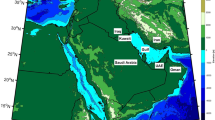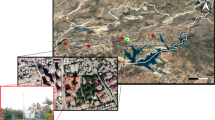Abstract
The Bay of Bengal Storm (BBS) frequently occurs during the “double-peak periods” in (1) May (pre-peak period) and (2) October to November (post-peak period). Exploring precipitation variation and its anomalies during these periods is crucial for understanding climate change in the Qinghai-Tibet Plateau (QTP). Precipitation products of MSWEP v2 (Multi-Source Weighted Ensemble Precipitation Version 2) along with precipitation observations from meteorological stations and BBS data from the Guam Joint Typhoon Warning Center from 1979 to 2020 were employed for the analysis. The objective of the present study was to investigate the anomalous characteristics and multi-temporal variability of regional precipitation over the QTP and its relationship with the BBS using the empirical orthogonal function (EOF), rotated empirical orthogonal function (REOF), and percentage calculation method. There was a consistent spatial distribution of precipitation on the QTP during double-peak periods based on the first mode of EOF. However, the second mode of EOF identified a northeast-southwest reverse in precipitation distribution. The QTP was categorized into five precipitation anomalous subregions during double-peak periods using REOF. Precipitation showed significant increases (12.6 mm/10a in May and 5.1 mm/10a in October to November) in specific regions. Precipitation anomalies on the QTP during double-peak periods exhibited positive anomalies at various timescales (monthly, ten-day, and pentad), with stronger BBS influence in the pre-peak period. From 1979 to 2020, all monthly precipitation anomalies on the QTP during double-peak periods were accompanied by BBS, with an 8% probability. The rates of precipitation anomalies under the influence of BBS were about 18% and 28% in the ten-day and pentad timescales, respectively, with BBS contributing the most to pentad precipitation anomalies. Daily precipitation anomalies during the pre-peak and post-peak periods were influenced by BBS to varying extents (30%, 20%, and 25% in May, October, and November, respectively). Extreme daily precipitation days affected by BBS represented 19%, 16%, and 21% of the statistical period extreme precipitation days in May, October, and November, respectively, with higher rates in the post-peak period.









Similar content being viewed by others
References
Bai L, Wen YQ, Shi CX, Yang YF, Zhang F, Wu J, Gu JX, Pan Y, Sun S, Meng JY (2020) Which precipitation product works best in the Qinghai-Tibet Plateau, multi-source blended data, global/regional reanalysis data, or satellite retrieved precipitation data? Remote Sens 12:683. https://doi.org/10.3390/rs12040683
Beck HE, Wood EF, Pan M, Fisher CK, Miralles DG, van Dijk AIJM, McVicar TR, Adler RF (2019) MSWEP V2 global 3-hourly 0.1° precipitation: methodology and quantitative assessment. Bull Am Meteorol Soc 100(3):473–500
Chen LS, Ding YH (1979) Introduction to typhoons in the western Pacific. Science Press, Beijing, pp 10–26
Dai JX (1990) Climate of the Qinghai-Tibet Plateau. Meteorological Press, Beijing, pp 1–365
Deng Y, Jiang WG, Wang XY, Lu JX (2018) Accuracy assessment of MSWEP precipitation products in the mainland China region. Adv Water Sci 29(4):455–464
Duan X, Duan W (2015) Impact of Bay of Bengal storms on precipitation over Plateau area. Plateau Meteorol 34(1):1–10
Duan X, Zhang JW (2015) The contribution of storms over the Bay of Bengal to the southwest water vapor transport during double-peak periods. Chin J Atmos Sci 39(3):526–534
Duan X, Tao Y, Cun CQ, Guo SC, Lv LY (2009) Temporal and spatial distributions of storms over the Bay of Bengal and its activity characteristic. Plateau Meteorol 28(3):634–641
Fan XT (2021) The characteristics of precipitation in China affected by cyclonic storms over the Bay of Bengal[D]. Beijing, Chinese Academy of Meteorological Sciences
Feng CY, Li CY, Zhou ZH, Chen WL, Yang WY (2022) Characteristics and trends of precipitation changes on the Qinghai-Tibet Plateau. Hydrology 42(1):75–79
Li XY, Yao ZY, Xiao JH, Wang HW (2016) Analysis of spatial and temporal variation characteristics of precipitation over the Tibetan Plateau from 1961 through 2010. J Glaciol Geocryol 38(5):1233–1240
Liu LS, Li Y, Wang L (2016) Anomalous characteristics of atmospheric circulation on the Tibetan Plateau during the Bay of Bengal storm activity in early summer. J Trop Meteorol 32(3):368–376
North JR, Bell T, Cahalan R, Moeng FJ (1982) Sampling errors in the estimation of empirical orthogonal function. Mon Weather Rev 110:699–706
Qiao QM, Zhang YG (1994) Weather science of Qinghai-Tibet Plateau. Meteorological Press, Beijing, pp 1–250
Qiao Y, Zhou SW, Ma Y, Wang CH, Li Q (2014) The dynamics of the Qinghai-Tibet Plateau and its impact on the weather and climate in China. Meteorol Sci Technol 42(6):1039–1046
Ren SL, Liu QM, Wu GX (2016) Statistical characteristics of the tropical cyclone activities over the Northwest Pacific and the Bay of Bengal during the Asian summer monsoon onset. Acta Meteor Sin 74(6):837–849
Shi XH, Xu XD, Xie LA (2006) Reliability analyses of anomalies of Ncep/Ncar reanalysis wind speed and surface temperature in climate change research in China. Acta Meteor Sin 64(6):709–722
Tropical Weather Research Group, Department of Geophysics, Peking University, General Forecasting Station, & State Oceanic Administration (1974) The activity of the Bay of Bengal storm and its influence on the weather in China. Meteorol Sci Technol 2(3–9):22
Wang TM, Wu GX, Wan RJ (2008) Influence of the mechanical and thermal forcing of Tibetan Plateau on the circulation of the Asian summer monsoon area. Plateau Meteorology 27:1–9
Wang YY, Guo H, Li GC, Guo ZD (2017) Precipitation estimation and analysis of the Three Gorges Dam Region (1979–2014) by combining gauge measurements and MSWEP with generalized additive model. Acta Geograph Sin 72(7):1207–1220
Wei FY (2007) Climate statistical diagnosis and prediction technology. Meteorological Press, Beijing
Wei ZG, Huang RH, Dong WJ (2003) Interannual and interdecadal variations of air temperature and precipitation over the Tibetan Plateau. Chin J Atmos Sci 27(2):157–170
Wu GX, Liu QM, Liu X, Duan AM, Liang XY (2005) How the heating over the Tibetan Plateau affects the Asian climate in summer. Chin J Atmos Sci 29:47–56
Wu GX, Duan AM, Zhang XQ, Liu QM, Ma YM, Yang K (2013) Extreme weather and climate changes and its environmental effects over the Tibetan Plateau. Chin J Nat 35:167–171
Wu Z, Xu Z, Wang F, He H, Zhou J, Wu X, Liu Z (2018) Hydrologic evaluation of multi-source satellite precipitation products for the Upper Huaihe River Basin China. Remote Sens 10:840. https://doi.org/10.3390/rs10060840
Xiao ZX, Duan AM (2015) Can the tropical storms originated from the Bay of Bengal impact the precipitation and soil moisture over the Tibetan Plateau? Sci China Earth Sci 58:915–928
Xu JW, Gao YH, Peng BF, Wang XQ (2020) Change characteristics of precipitation and its cause during 1979–2016 over the Qinghai-Tibetan Plateau. Meteorology 39(2):234–244
Yang S, Li QX (2014) Improvement in homogeneity analysis method and update of China precipitation data. Clim Chang Res 4:276–281
Zhang L, Miao QL (2007) Precipitation changes in the Tibetan Plateau during the last four decades. Arid Land Geogr 30(2):240–246
Zhao Y (2016) Mechanism of the influence of the large-scale topography and water vapor transport structure of the Tibetan Plateau on the extreme events of heavy rainfall time and space distribution in Eastern China[D]. Beijing, Chinese Academy of Meteorological Sciences
Zhu FK, Zheng XJ, Luo JN, Li ZZ (1998) Water vapor images of the snowstorm process in southern Tibet. Chin Sci Bull 43:2232–2235
Acknowledgements
The authors would like to thank the data providers and Editage (www.editage.cn) for English language editing. And the authors also appreciate the constructive opinions from the editor of this paper and the two anonymous reviewers.
Funding
The study was supported by the National Key Natural Science Foundation of China (grant no. 41930972) and the Youth Science and Technology Fund Program of Gansu Province (grant no. 20JR5RA112).
Author information
Authors and Affiliations
Contributions
Jinsong Wang ,Ying Li and Jing Wu wrote the main manuscript text and Jing Wu prepared all figures. All authors reviewed the manuscript.
Corresponding authors
Ethics declarations
Competing interests
The authors declare no competing interests.
Additional information
Publisher's Note
Springer Nature remains neutral with regard to jurisdictional claims in published maps and institutional affiliations.
Supplementary Information
Below is the link to the electronic supplementary material.
Rights and permissions
Springer Nature or its licensor (e.g. a society or other partner) holds exclusive rights to this article under a publishing agreement with the author(s) or other rightsholder(s); author self-archiving of the accepted manuscript version of this article is solely governed by the terms of such publishing agreement and applicable law.
About this article
Cite this article
Wang, J., Li, Y. & Wu, J. Precipitation anomalies over Qinghai-Tibet Plateau during Bay of Bengal Storm double-peak periods. Theor Appl Climatol 155, 3133–3146 (2024). https://doi.org/10.1007/s00704-023-04806-5
Received:
Accepted:
Published:
Issue Date:
DOI: https://doi.org/10.1007/s00704-023-04806-5




